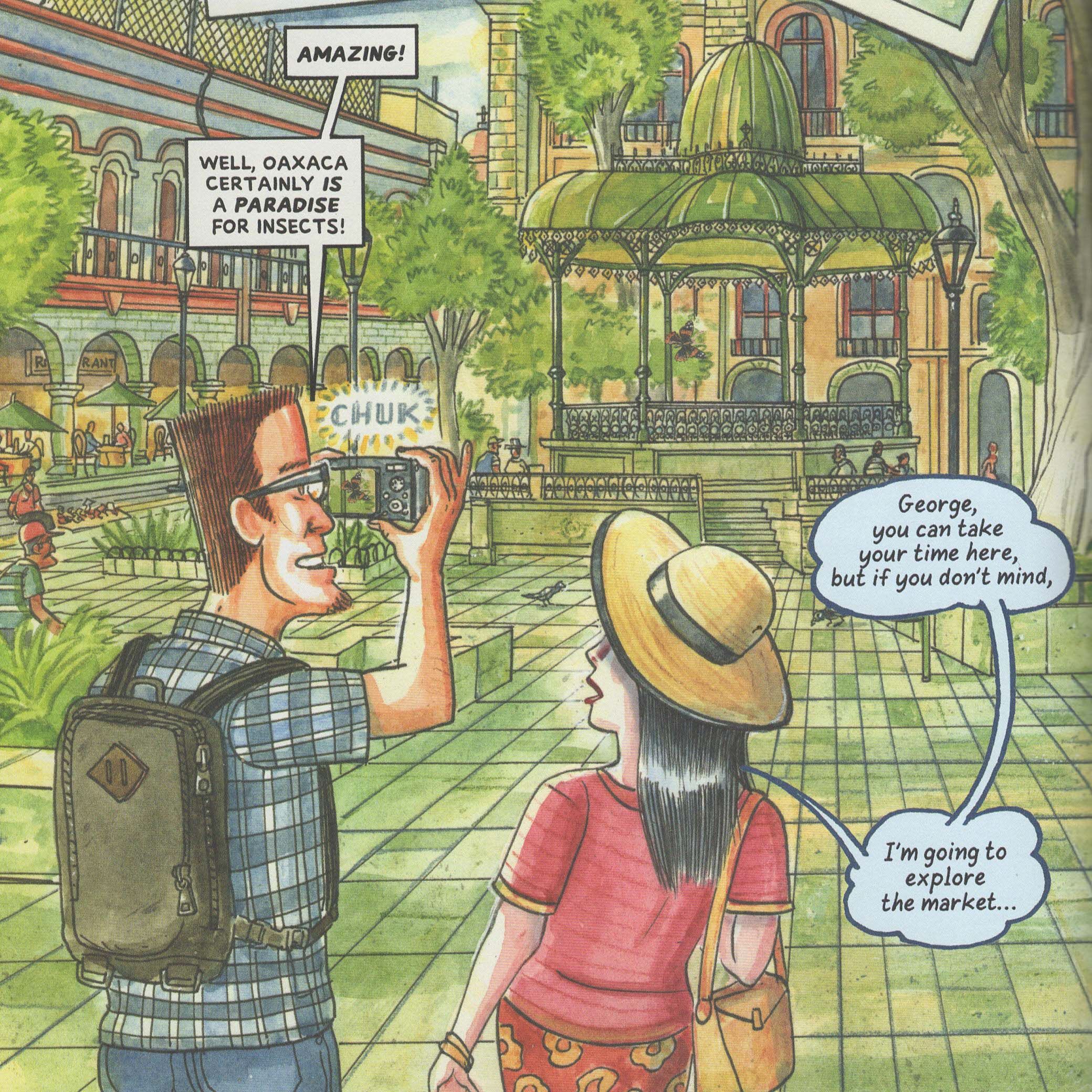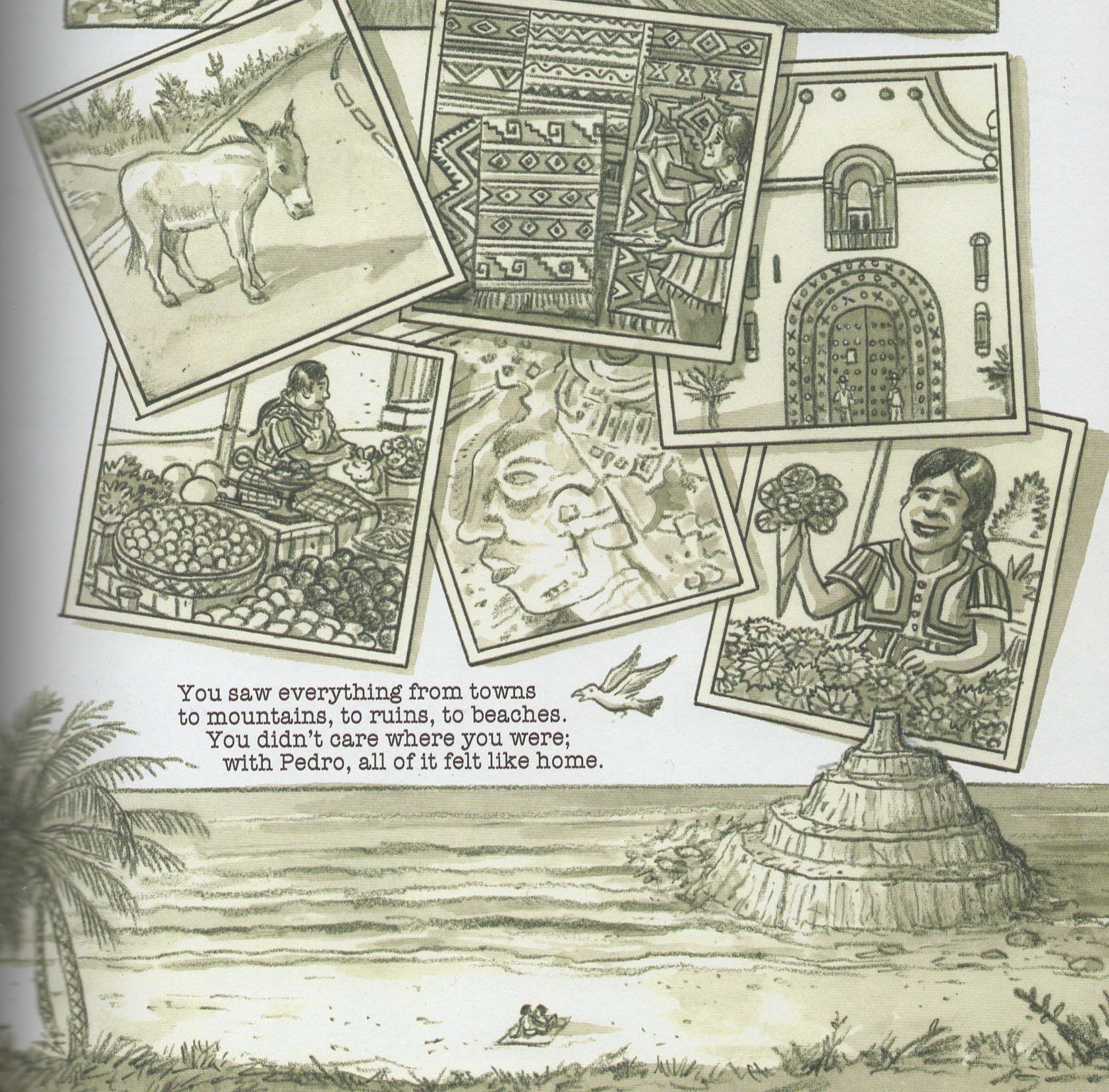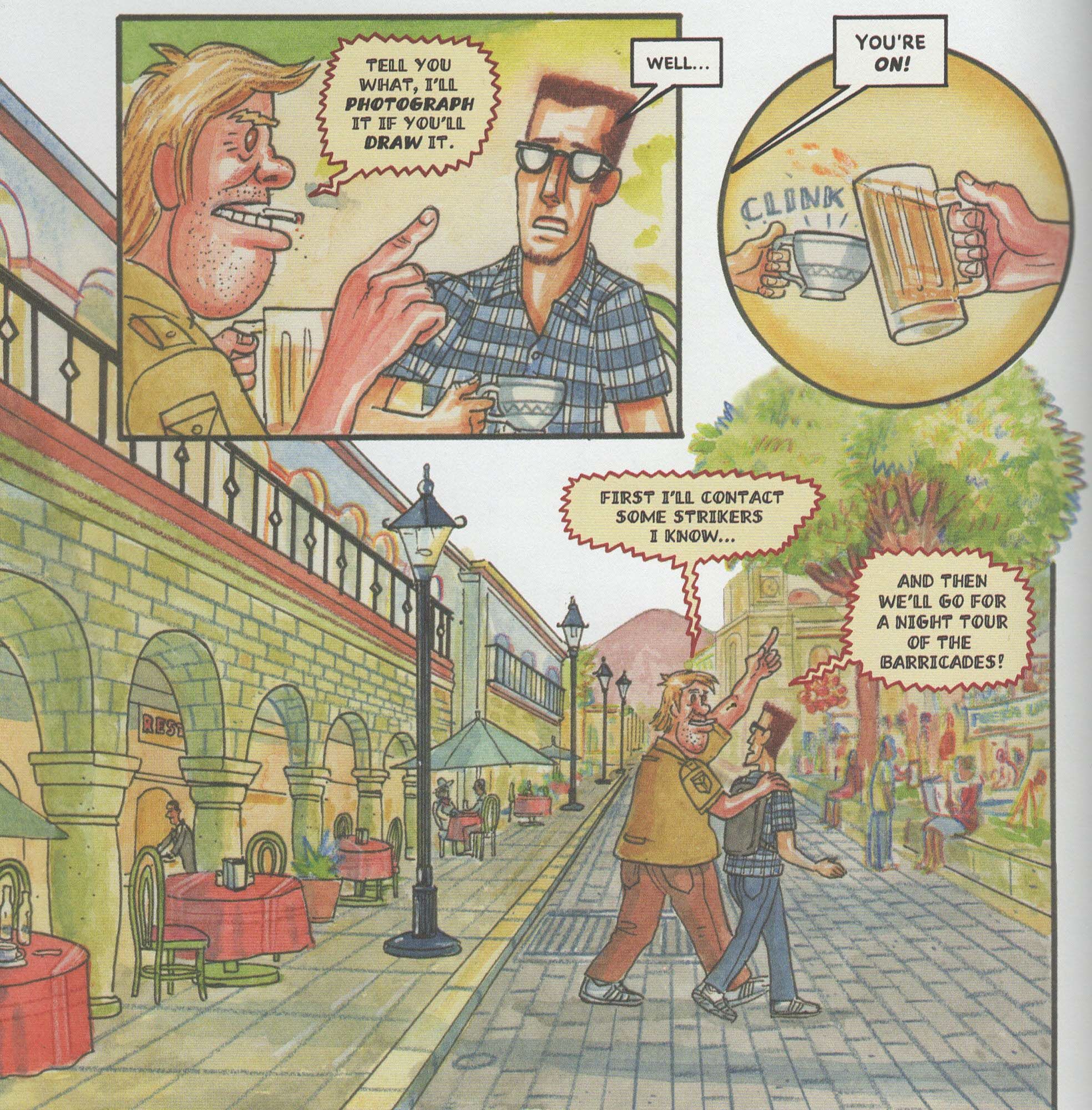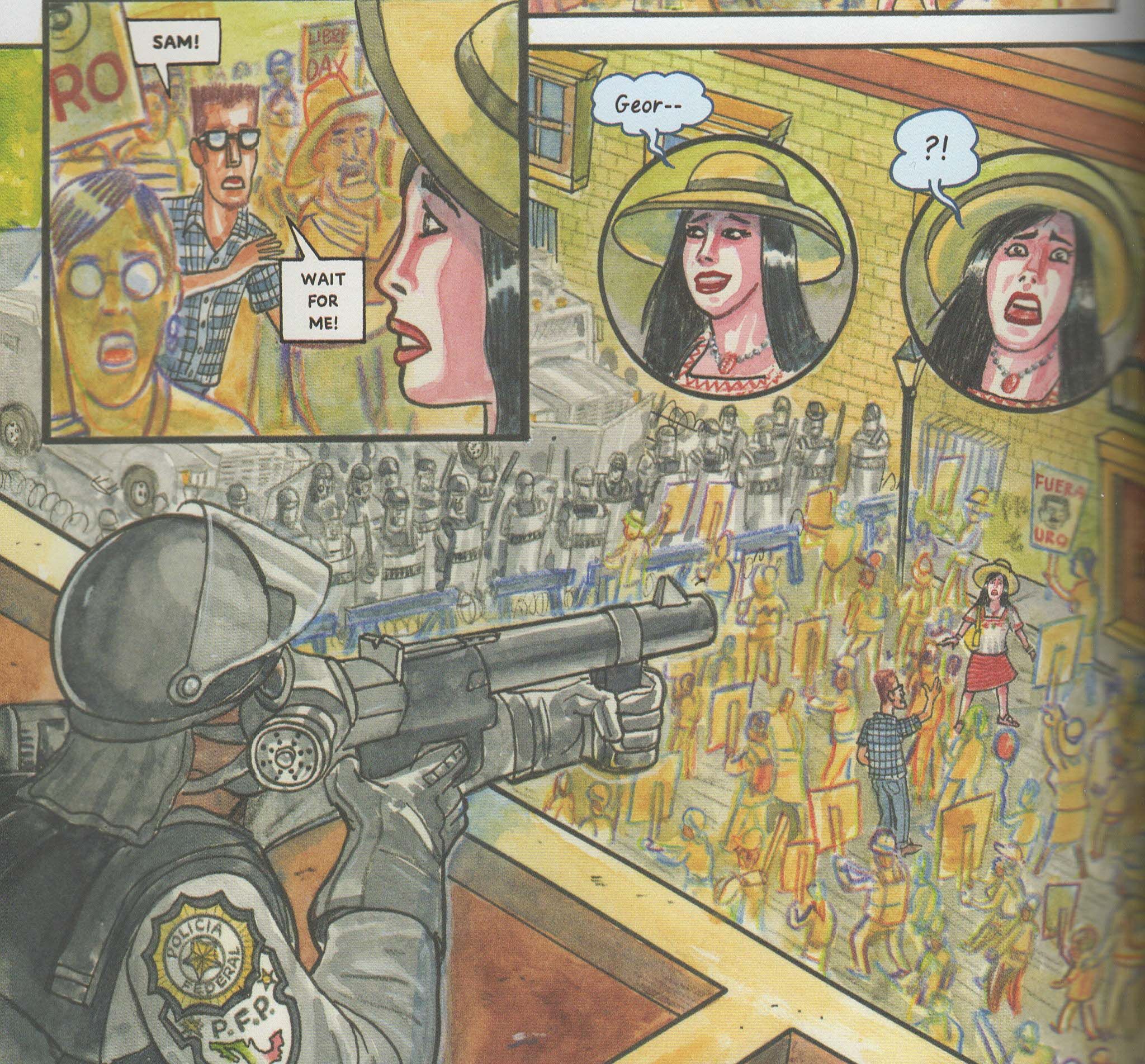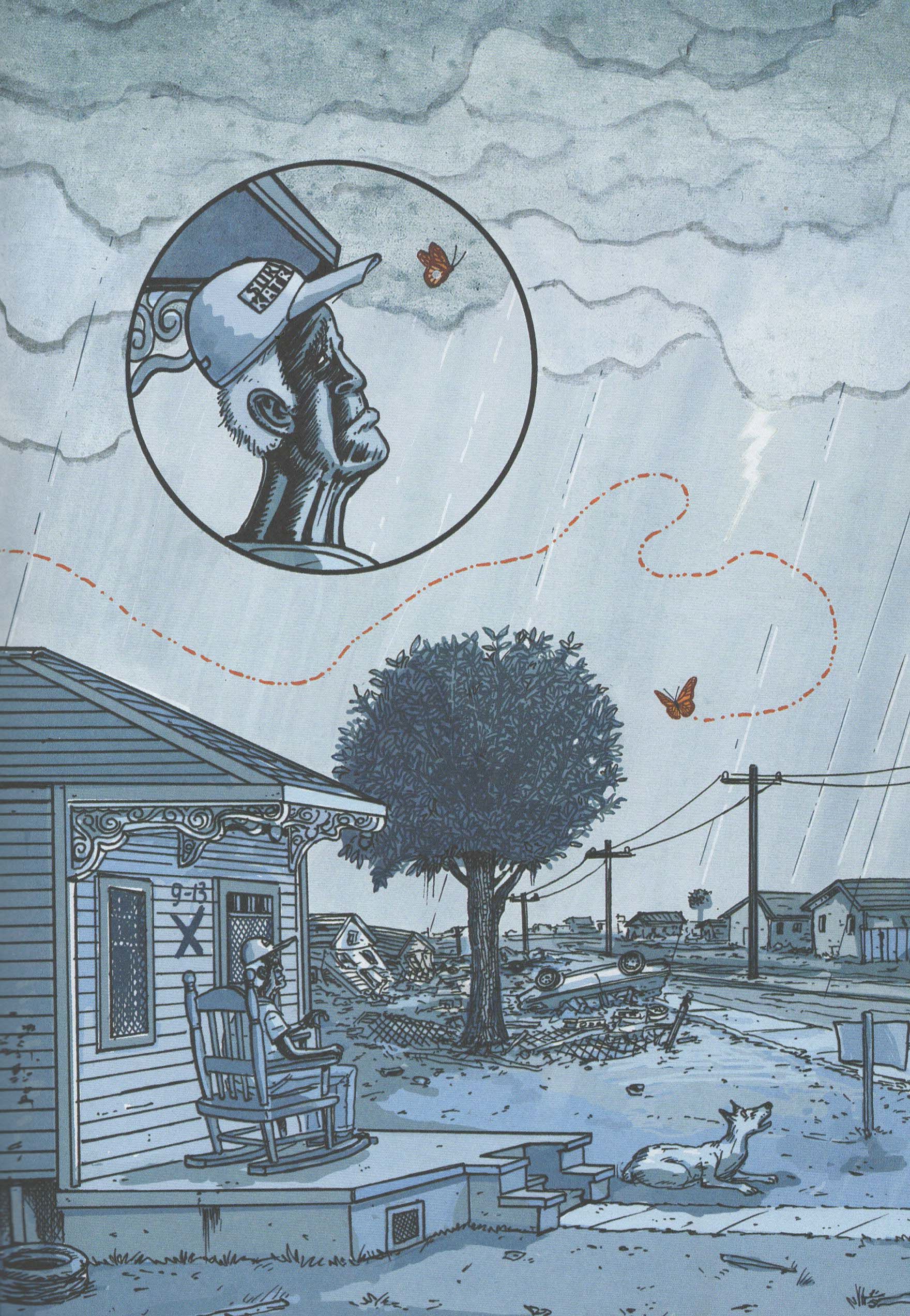"Our bones forever in stone, monuments of life"
I'm pretty sure Ruins is the first Peter Kuper book I've ever read, even though he has a fine reputation around the comics literati and he's been working for a long time.
It was partly his reputation that interested me about this, which is a nice, thick hardcover from SelfMadeHero and is priced at $29.95.
Kuper's art is apparently his calling card, and I agree with that, as his art in this book is pretty spectacular. His story leaves more to be desired, unfortunately, and it's why I don't like this book more. But let's focus on his art first, because it really is beautiful. He has what I think of as an "indie" style, in that his work is a bit more angular and less "action-ready" than you'll see in mainstream superhero books, so we get generally stiff characters as they stroll around Oaxaca (where most of the book takes place). Otherwise, his art is amazing, as he shows both the beauty and squalor of Oaxaca and Mexico in general without being too obvious about it - he wants to show the beauty more, because he's contrasting the richness of the native culture with the cold plasticity of American culture (yes, this is partly a cultural criticism), but he wisely shows all of Oaxaca, making the location a complex reality.
There are some astonishing scenes of everyday life, such as when George and Sam, the protagonists, head to a local market, and Kuper crams the page with stalls full of fruit, colorfully dressed locals, and stray cats hunting insects. The central square of Oaxaca, where a good deal of the action occurs, is a lovely rendition, as Kuper takes time to show all the beautiful architecture of the buildings ringing the space. George and Sam have rented a house, and Kuper does a great job giving us a sense of the place so that we always know where they are in relation to each other. He does marvelous work with the landscape, too, filling it with palm trees, fruit trees, and flowers. His people are fascinating - George and Sam are so Anglo it's very funny, as George is the only one in the book who wears shorts and Sam tries too hard to adopt local clothing, while Alejandro is a lunk with a big heart, Francisco is far too suave, and Angelina the housekeeper always looks just a bit harried. Kuper populates the book with locals, all of whom are unique and add a great deal to the personality of the comic. We get a great sense of the history of the area, too - Sam is working on a book, and she uses that to daydream about the way the region used to look and how the Spaniards changed it.
Kuper does a wonderful job using different line weights, too - when Sam flashes back to her earlier time in Oaxaca, he uses a lighter line and an ink wash to place it in the past, which isn't revolutionary but still works well. His colors are spectacular, too - everything in Mexico is bright and vibrant, in contrast to the muted blues and grays he uses in New York (with some exceptions - some of the stuff in New York is bright, but it's set against a drab background). Kuper wants to show how much closer to nature the Mexicans are, so he uses a riot of colors to bring the manmade parts of their world in tune with the natural colors all around them, and it's really well done. It appears that at least some of the coloring is done with watercolors, and Kuper uses them to create wonderful shading, and to make rain and fire look more natural. Meanwhile, in the sections of the book that deal with the butterfly, he uses much sharper lines to contrast the brutal reality over which the butterfly flits with the colorful life in Oaxaca. The coloring in these sections is blue (except for the actual butterfly), which is another nice contrast with the rest of the book. It's still Kuper, but the slight shift in style to a harder line is well done, making these parts stand out nicely.
Kuper's story doesn't quite hold up in concert with the art. It's just there, full of clichés. George and Sam leave New York and fly to Oaxaca for a six-month sabbatical, where Sam hopes to work on a book and George hopes to figure out what he should do after getting laid off.
He was an entomologist, but he was once a painter, and he has no idea where he should go in life. Their marriage is in a bit of trouble, too - it's not over, but they seem distant from each other, and we soon learn it's because Sam wants children and George doesn't. They meet some people - Sam meets a local artist, Francisco; George befriends Alejandro, a photojournalist who has dropped out of society because of the horrors he's seen; they both become friends with another George, an ex-pat Brit who runs the English-language bookstore in town. Things play out pretty much as we expect - George and Sam don't really reconnect, as George becomes fascinated by the insects around town, hangs out with Alejandro too much, and becomes despondent when the real world intrudes too much on his vacation. Sam is a bit too friendly with Francisco, and is stuck in the past, as she reminisces about her first marriage to a local Mexican and the baby she miscarried. Neither of them really talk to each other - they talk at each other a lot, but neither of them really listen - and Kuper presents their dilemma in the most basic ways possible. It's hard to believe that Sam would enter into another marriage without discussing children first, given how her first marriage turned out, but it seems like her desire for children always takes George by surprise.
She seems to want George to return to his artistic roots, but it's not clear whether it's because she thinks he'd be happier (he seems quite happy cataloging bugs) or if it's because she thinks it's more romantic. Neither of them discuss the long-term economic options available if they have children. George is a bit of a man-child, refusing to drive (for no good reason) and drinking too much to escape his wife. Kuper delves into the history of the region, but it's in a fairly bland way, and even the tension of a teachers' strike and the subsequent violence when the corrupt governor tries to squash it is presented in as basic a way as possible. Neither George nor Sam is all that interesting, and neither comes off very well, as they fall into the most stereotypical slots you can imagine. Even the short sections with the butterfly are predictable - Kuper shows the butterfly leaving New York for its winter home in Mexico (mirroring George and Sam's journey), and along the way, it flies past Three Mile Island, over strip mining in West Virginia, past evil Monsanto foremen yelling at their workers, over Katrina-ravaged New Orleans (the book is set in 2006), over illegal immigrants getting caught by the border patrol, through violent Mexican neighborhoods, and through the beautiful desert before arriving in Oaxaca. It all appears to be a comment on how horrible people are, but it's done in such a heavy-handed fashion that it becomes dull and vaguely insulting. The entire book is unsubtle, and the butterfly sections just highlight that.
It makes me sad when the art on a book is so good but the story is so far behind, but with Ruins, that's what we get. Kuper's amazing art keeps the book from being too annoying, but the story about two relatively selfish and self-centered people can't quite redeem it. It's one of those books where very short sections of the story kind of work, but overall, it just falls flat. It's just too bad.
Rating: ★ ★ ★ ★ ★ ½ ☆ ☆ ☆ ☆


